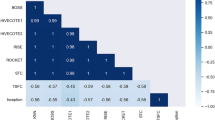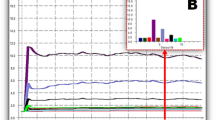Abstract
Current clinical diagnostics are based on biochemical, immunological or microbiological methods. However, these methods are operator dependent, time-consuming and expensive and require special skills, and are therefore not suitable for point-of-care testing. Developments in gas-sensing technology and pattern recognition methods make electronic nose technology an interesting alternative for medical point-of-care devices. In this paper, the potential of an electronic nose as a monitoring tool in clinical microbiology is investigated through two case studies. Initially, an electronic nose based on chemoresistive sensors has been employed to identify in vitro 13 bacterial clinical isolates, collected from patients diagnosed with pathological infections in a Public Health Laboratory environment, while in a later stage, analysis was carried out for urinary tract infection-suspected cases incubated in a volatile generation test tube system for 4–5 h. Two issues have been considered the application of an advanced wavelet neural network and the concept of the fusion of multiple classifiers dedicated to specific feature parameters. The adopted wavelet neural network incorporates a “product operation” layer between wavelet functions and output layers, while the connection weights at output layer have been replaced by a local linear model. This study has shown the potential for early and fast detection of microbial contaminants in clinical samples utilising advanced learning-based algorithms and electronic nose technology.




Similar content being viewed by others
References
Moret-Bonillo V (1998) Integration of data information and knowledge in intelligent patient monitoring. Expert Syst Appl 15:155–163
Woodman AC, Fend R (2004) Electronic-nose technology, potential applications in point-of-care clinical diagnosis and management. In: Price CP, John AS, Hicks JM (eds) Point-of-care testing, 2nd edn. AACC Press, Washington
Brown DJ (1985) A method for determining the excretion of volatiles substances through skin. Methods Find Exp Clin Pharmacol 7:269–274
Phillips M (1997) Method for the collection and assay of volatile organic compounds in breath. Anal Biochem 247:272–278
Sarig Y (2000) Potential applications of artificial olfactory sensing for quality evaluation of fresh produce. J Agric Eng Res 77(3):239–258
Gostelow P, Parsons SA, Stuetz RM (2001) Odour measurements for sewage treatment works. Water Res 35(3):579–597
Albert KJ, Lewis NS, Schauer CL, Sotzing GA, Stitzel SE, Vaid TP, Walt DR (2000) Cross-reactive chemical sensor arrays. Chem Rev 100:2595–2626
Persaud K, Dodd GH (1982) Analysis of discrimination mechanisms of the mammalian olfactory system using a model nose. Nature 299:352–355
Covington JA, Gardner JW, Hamilton A, Pearce TC, Tan SL (2007) Towards a truly biomimetic olfactory microsystem: an artificial olfactory mucosa. IET Nanobiotechnol 1(2):15–21
James D, Scott S, Ali Z, O’Hare WT (2005) Chemical sensors for electronic nose systems. Microchim Acta 149:1–17
Ampuero S, Bosset J (2003) The electronic nose applied to dairy products: a review. Sens Actuators B 94:1–12
Mwakikunga BW, Malwela T, Hillie KT, Ndlovu G (2011) Towards an electronic nose based on nano-structured transition metal oxides activated by a tuneable UV light source. IEEE Sensors: 1109–1112
Peris M, Escuder-Gilabert L (2009) A 21st century technique for food control: electronic noses. Anal Chim Acta 638:1–15
Pearce T, Schiffman S, Nagle H, Gardner J (2002) Handbook of machine olfaction: electronic nose technology. Wiley-VCH, New York
Zubritsky E (2009) Product review: e-noses keep an eye on the future. Anal Chem 72(11):421A–426A
Persaud K, Pisanelli AM, Evans P, Travers P (2006) Monitoring urinary tract infections and bacterial vaginosis. Sens Actuators B 116:116–120
Hanson CW III, Steinberger HA (1997) The use of a novel electronic nose to diagnose the presence of intrapulmonary infection. Anaesthesiology 87(3):269
Pavlou A, Magan N, Meecham J, Brown J, Klatser P, Turner APF (2004) Detection of Mycobacterium tuberculosis (TB) in vitro and in situ using an electronic nose in combination with a neural network system. Biosens Bioelectron 20:538–544
Kodogiannis VS, Wadge E (2005) The use of gas-sensor arrays to diagnose urinary tract infections. Int J Neural Syst (IJNS), World Scientific Publ. 15(5):363–376
Pavlou AK, Kodogiannis VS, Turner APF (2001) Intelligent classification of bacterial clinical isolates in vitro, using electronic noses. In: International conference on neural networks and expert Systems in medicine and healthcare, pp 231–23
Di Natale C, Mantini A, Macagnano A, D’Amico A (1999) Electronic nose analysis of urine samples containing blood. Physiol Meas 20(4):377–384
Wang P (1997) A novel method for diabetes diagnosis based on electronic noses. Biosens Bioelectron 12:1031–1036
Di Natale C, Macagnano A, Martinelli E, Paolesse R, D’Arcangelo G, Roscioni C, Finazzi-Agro A, D’Amico A (2003) Lung cancer identification by the analysis of breath by means of an array of non-selective gas sensors. Biosens Bioelectron 1:1–10
Amina M, Kodogiannis VS, Petrounias I, Lygouras JN, Nychas G-JE (2012) Identification of the Listeria Monocytogenes survival curves in UHT whole milk utilising local linear wavelet neural networks. Expert Syst Appl 39(1):1435–1450
Jang J-SR (1993) ANFIS: adaptive-network-based fuzzy inference systems. IEEE Trans Syst Man Cybern 23:665–685
Fend R, Bessant C, Williams AJ, Woodman AC (2004) Monitoring haemodialysis using electronic nose and chemometrics. Biosens Bioelectron 19(12):1581–1590
Pavlou AK, Magan N, Sharp D, Brown J, Barr H, Turner APF (2000) An intelligent rapid odour recognition model in discrimination of Helicobacter pylori and other gastroesophageal isolates in vitro. Biosens Bioelectron 15:333–342
Kodogiannis VS, Pavlou AK, Chountas P, Turner APF (2003) Evolutionary computing techniques for diagnosis of urinary tract infections in vivo, using gas sensors. In: Neural Computing and Soft Computing, Springer, Berlin. Series: Advances in Soft Computing, pp 474–479
Dickinson TA, White J, Kauer JS, Walt DR (1998) Current trends in artificial-nose technology. Trends Biotechnol 16:250–258
Bartlett PN, Elliott JM, Gardner JW (1997) Application of and developments in machine olfaction. Anal Chim 87:33–44
Fend R (2004) Development of medical point-of-care applications for renal medicine and tuberculosis based on electronic nose technology. PhD Thesis, Cranfield University
Guobin O, Murphey YL (2007) Multi-class pattern classification using neural networks. Pattern Recogn 40:4–18
Sugeno M (1977) Fuzzy measures and fuzzy integrals: a survey. In: Gupta MM, Saridis GN, Gaines BR (eds) Fuzzy Automata and Decision Processes. North-Holland, pp 89–102
Yager R (1993) A general approach to criteria aggregation using fuzzy measures. Int J Man Mach Stud 39(2):187–213
Grabisch M, Murofushi T, Sugeno M (1992) Fuzzy measure of fuzzy events defined by fuzzy integrals. Fuzzy Sets Syst 50:293–313
Mitra S, Pal SK, Mitra P (2002) Data mining in soft computing framework: a survey. IEEE Trans Neural Netw 13(1):3–14
Kuncheva LI (2000) Fuzzy classifier design. Physica-Verlag, Wurzburg
Zhang Q, Benveniste A (1992) Wavelet networks. IEEE Trans Neural Netw 3(6):89–98
Ribes-Gómez E, McLoone S, Irwin G (2008) A taxonomy for wavelet neural networks applied to nonlinear modelling. Int J Syst Sci 39(6):607–627
Xu J, Ho DWC (2005) A constructive algorithm for wavelet neural net. Lect Notes Comput Sci 3610:730–739
Jahankhani P, Kodogiannis VS, Lygouras JN, Petrounias IP (2011) A decision support system for EEG signals based on Adaptive inference neural networks. J Comput Methods Sci Eng (JCMSE), IOS Press, 11(4):209–225
Kodogiannis VS, Amina M, Petrounias I (2013) A clustering-based fuzzy-wavelet neural network model for short-term load forecasting. Int J Neural Syst 23(5):1–19
Kodogiannis VS, Boulougoura M, Lygouras JN, Petrounias I (2007) A neuro-fuzzy based system for detecting abnormal patterns in wireless-capsule endoscopic images. Neurocomputing 70(4–6):704–717
Nelles O (2000) Nonlinear system identification. Springer, Berlin
Tax D, van Breukelen M, Duin R, Kittler J (2000) Combining multiple classifiers by averaging or by multiplying? Pattern Recogn 33:1475–1485
Kodogiannis VS, Petrounias I, Lygouras JN (2009) An intelligent decision support system for bacterial clinical isolates in vitro, utilising an electronic nose. Intell Decis Technol 3(4):219–231
Kodogiannis VS, Lygouras J, Tarczynski A, Chowdrey HS (2008) Artificial odour discrimination system using electronic nose and neural networks for the identification of urinary track infection. IEEE Trans Inform Technol Biomed 12(6):707–713
Author information
Authors and Affiliations
Corresponding author
Rights and permissions
About this article
Cite this article
Kodogiannis, V.S. Point-of-care diagnosis of bacterial pathogens in vitro, utilising an electronic nose and wavelet neural networks. Neural Comput & Applic 25, 353–366 (2014). https://doi.org/10.1007/s00521-013-1494-8
Received:
Accepted:
Published:
Issue Date:
DOI: https://doi.org/10.1007/s00521-013-1494-8




